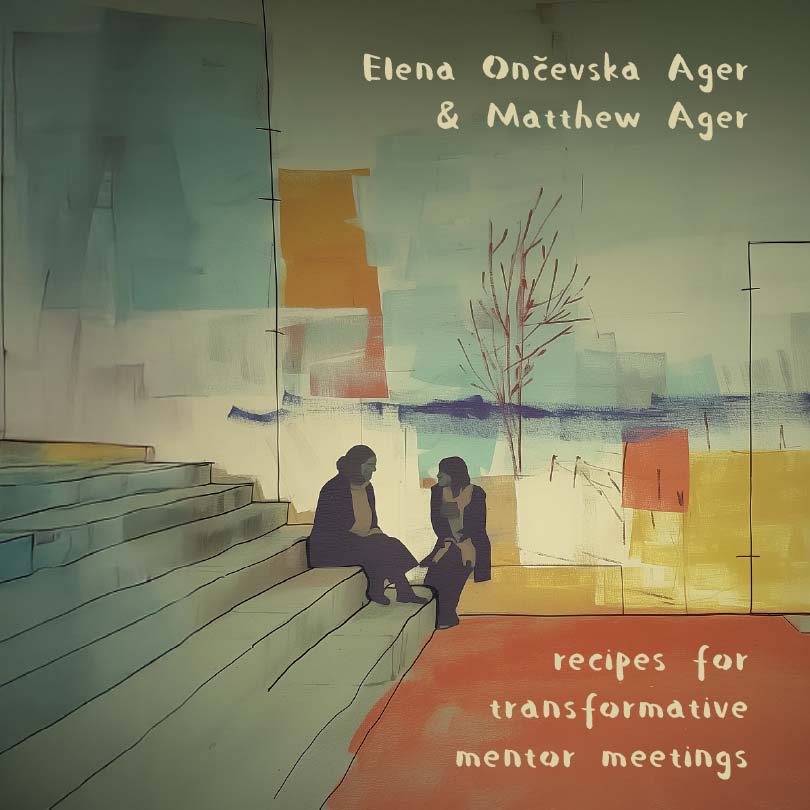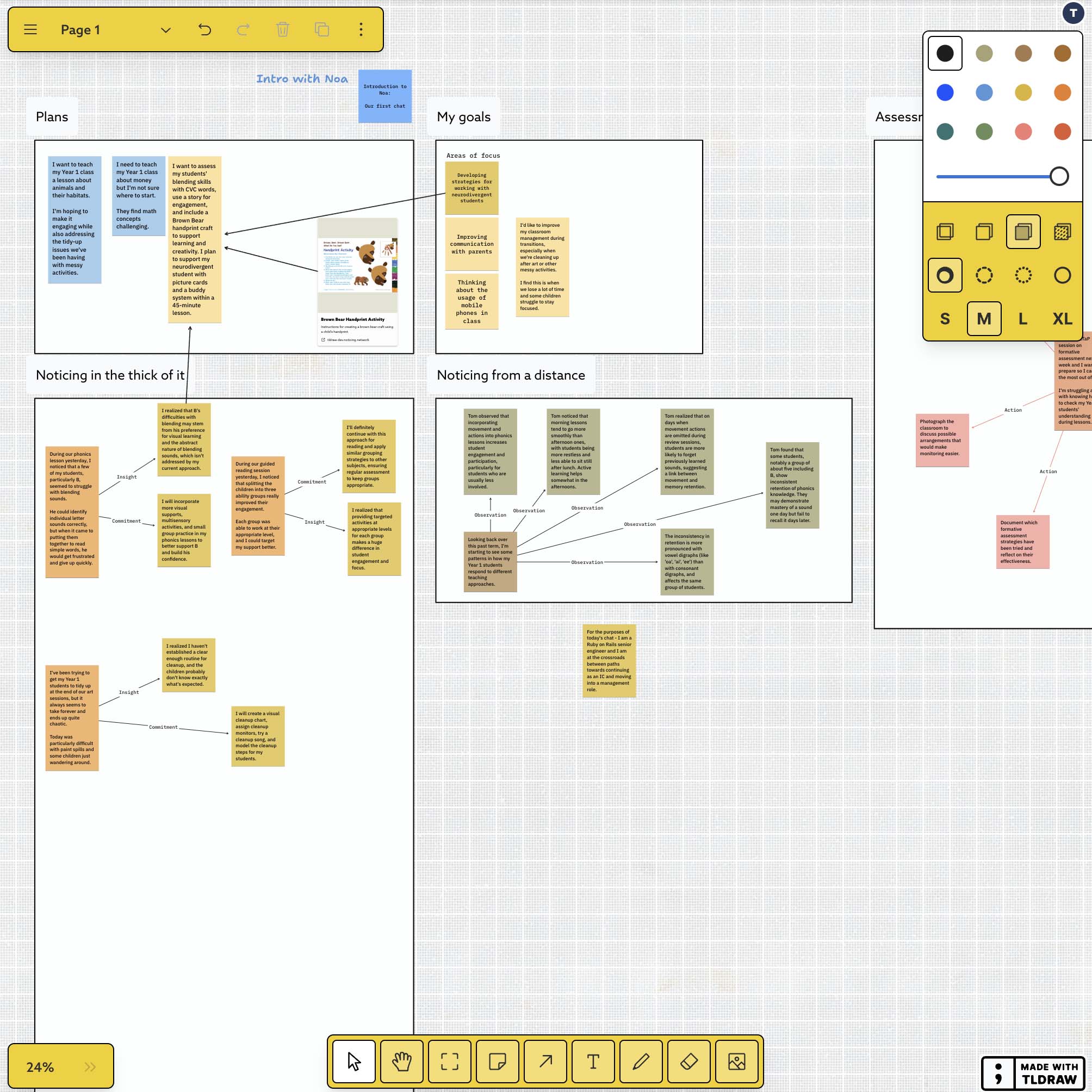
Noa–2
Posted on 16th May 2025 byElena Oncevska Ager & Matthew Ager
Over the last year of conversation and collaboration with colleagues in Australia, Pakistan, Switzerland, the UK, and beyond, our understanding of reflective practice and the role of Generative AI as a facilitator have evolved, so this post is primarily thanks to all who have contributed, and continue to contribute, to that growing understanding.
Today we are releasing Noa–2, our AI assistant middleware. It is a significant step forward in our development of Noa, and we are excited to share with you. The below also outlines some of the new features and capabilities of Noticing which have been built to take full advantage of Noa–2, and how they relate to our understanding of reflective practice and the role of Generative AI as a facilitator.
At the beginning of this year, like many, Elena and I were reflecting both retrospectively on 2024 and in anticipation of 2025; we had started writing up some of our ongoing research, having setup calls with colleagues and students for new projects involving Noticing, and roadmapping new features for the platform. Personally, I had started to read a lot, partially as I need to if I am to be able to effectively contribute to the literature, but more because I felt that I need to own my understandings of the pedagogical and psychological aspects of what we are doing; also new articles were appearing in earnest, now that enough time has passed since GenAI went mainstream for findings to be published.
Notably, I decided to shore up my understanding of Mason's (2002; 2011; 2020) Discipline of Noticing. My exposure to it had been solely through Angi Malderez's (2015; 2024) applications and its underpinnings of SIRP, where noticing relates to standout classroom events, but having not gone back to basic principles, I felt I had a superficial grasp. What I hadn't anticipated was finding out that John Mason is a mathematician, and that 'noticing' is at its core a construct for supporting (but also a necessity for and consequence of) mathematical thinking, sense-making and problem-solving. That means that a mentor's post-lesson role in supporting their teacher's deeper reflection on practice is of a kind with a teacher's in-the-moment role in embracing their students' struggle with complex problems, and that ushering towards 'productive struggle' (Warshauer 2015), is useful for both.
Noticing is a completely natural concept to me, I am a noticer, a pattern-spotter—I experience things, often at first chaotically (I don't avoid struggle), and then my under-mind ticks away doing the learning for me, more often than not while I'm asleep, waking up thinking "well, isn't that interesting!" And so it must be (!), as this was the aspect of SIRP that most connected with my view of the universe and the trigger for Elena and me to start on our Noticing journey together. I had found formal education underwhelming at best, idling, except when I was challenged and would surpass teachers' expectations; increasingly challenged and engaged as I went through collage, university and ultimately to a PhD in mathematics.
Out of necessity (because I was never satisfied with what I was being told) I developed a habit of working things through in my head after the fact—as a self-directed learner, I facilitate my own sense-making. I therefore internally sit on both sides of the educator/learner fence and now realise that the noticing I do through reflecting in action to solve complex (mathematical or other) problems is the same as the noticing that I do when reflecting on action to learn from my experiences—that deferring judgement, starting with what is known while recognising what is assumed, being assertive while challenging internal ideas, confirming and justifying conjectures, effectively handling gaps in knowledge etc. are the fundamentals of both.
For Noticing, this was transformative as it had been designed to support the development of users' sensitivity to noticing in-the-moment by systematically practicing noticing through reflecting on standout events from their practice. As such, Noa's role was as facilitator of process, scaffolder of thinking and occasional contributor. However, this new understanding led us to realise that if Noa can also simulate listening and have prepared actions to usher users towards productive struggle, then Noticing would not only be a tool for reflection, but more generally a tool for sense-making and problem-solving, and therefore a tool for any kind of learning.
To see what is in front of one’s nose needs a constant struggle. One thing that helps toward it is to keep a diary, or, at any rate, to keep some kind of record of one’s opinions about important events [...]. To discover why one was right can be very illuminating. [...] One cannot, of course, get rid of one’s subjective feelings, but one can to some extent insulate them from one’s thinking [...].
We have consistently differentiated Noticing from first-party GenAI applications by emphasising that Noa is strongly instructed to avoid content generation, in favour of generating scaffolds to facilitate users' deeper thinking (what a good mentor would do). This is not least because we do not trust GenAI to know what it is talking about—we cannot know whether it is trained on good pedagogy or not—and so we felt reluctant to allow Noa a more liberal Educator role.
Aside from developing noticing skills, one of SIRP's aims is to support the development of learnacy (Claxton, 2004), and we had to date felt stymied by GenAI's insufficiency. Happily, Elena shared Andrea English et al.'s (2023) article on 'Pedagogical Listening' with me, having attended a talk by the first author at BERA 2024 in Manchester. 'Happily' shared because once again, while Elena had been drawn to the psychological aspects and potential applications in her teaching of her pre-service teachers, my noticing shifted into top gear upon seeing that the article centres around mathematical sense-making discussions, and moreover, that Mason and English share common literature roots in Dewey, Freire, Polya, Lakatos, and Schoenfeld.
These insights from Mason, English and others culminated in the theoretical backing that we needed to have the confidence to push ahead with a second version of Noa, one which could be applied to a wider range of learning situations, and which could be more effective in supporting users' development. Below are some notable principles that influenced the subsequent development:
- A conjecturing atmosphere supports the kind of free and open discussion that is needed to facilitate the generation of new ideas and learning—productive struggle—and this is true for both for students solving mathematical problems and for teachers reflecting on their practice.
- Struggle is productive when it prompts reflection on the limits of prior understanding, and sustains engagement towards new realisations.
- Attending to what a learner is expressing, or attempting to, differs significantly from seeking confirmation of pre-existing ideas; and questioning by an educator can too easily become "guess what I am thinking".
- Being prepared to act appropriately in response to what a learner is expressing is key to supporting productive struggle; appropriate actions will vary and depend on the circumstances, but can be realised ahead of time.
- Last but not least, every conversation currently supported by Noticing, both in anticipation and retrospectively, both in-the-moment and from a distance, is grounded in Dewey's notion of inquiry, just of varying scales.
OK, so what does all this mean for Noticing from today onwards?
- Prompting
- We have reviewed and updated all of Noa's prompts, including those for behaviour and role, to ensure that they are directed towards creating conjecturing atmospheres through pedagogical listening which (hopefully) result in productive struggle. Noa was evaluating before responding long before 'reasoning' models were a thing, and we have doubled-down on this approach—Noa will transparently simulate listening, and use theory-informed techniques (see Mason's 'Powers', 2008) to usher users towards moments of fruitful uncertainty, while being on the lookout for developing competencies.
- Transparency
-
We have written a book of
Recipes for Transformative Mentor Meetings (available to purchase now),
in which the 'ingredients lists' consist of what a good mentor will look to
prompt for… and, subsequently, to listen for… and optionally reflect back...,
in order … to develop competency in… at each step of each conversation—Noa uses these internally, and they are visible to users via Noa's Notes
in the sidebar of the conversations.

- Organisation
- Additionally, while writing and organising the booklet, we realised that there was a more intuitive way to organise the conversations within Noticing, first by the proximity of the conversation to the 'event' (in-the-moment or from a distance), and then by whether the event was in the past or future. We think this connects more naturally to ongoing practice, and allows users to find the right conversation more easily.
- The Big Picture
-
We were concerned about the siloed nature of the conversations within Noticing, and indeed with almost all
GenAI interactions, but in this case they poorly reflect the interconnected messiness of real life and
professional development, and the organisation of Noticing's user interface did not help with that. We
have built an infinite canvas to record noticings, insights and plans, and link to knowledge and with each
other—an ongoing visual workspace where conversations with Noa can be simply
initiated based on singular thoughts and groups of ideas. We hope this space, through organising and
categorising, reveals the general from the specific, and the specific from the general.

- Collaboration
- Connection with the real world has always been a key part of Noticing, through the sharing of conversations with peers and mentors, and more recently through multi-user conversations in which Noa moderates 'micro-brainstorming' at each step. Users can also explore the big picture together through shared canvases with realtime collaboration—collective whiteboarding, with the opportunity to follow up with individual reflection, and even group discussion.
- Choice
- Finally, as GenAI models continue to stabilise in both ability and cost, we are excited to announce that users will now be able to choose which model they would like to use (OpenAI, Anthropic, Google, Cohere for now) for each conversation with Noa. Each model has its own strengths and weaknesses, and even perceptible personality, and we are interested to see how users will choose to use them.
We are excited to see how these changes will impact the way users interact with Noa and how they will enhance the overall experience of using Noticing. We believe that these changes will help users to develop their noticing skills, and to become more effective problem-solvers and sense-makers.
Written by Elena Oncevska Ager
Written by Elena Oncevska Ager
Elena Oncevska Ager is Full Professor in Applied Linguistics at Ss Cyril and Methodius University
in Skopje, North Macedonia.
Her work involves teaching English for Academic Purposes (EAP) and supporting the development of English
language teachers, in face-to-face and online contexts. Her research interests revolve around EAP and
language teacher education, with a focus on mentoring, group dynamics, motivation, learner/teacher
autonomy and wellbeing.
Elena is particularly interested in facilitating reflective practice, in its many forms, including
through using the arts and by using AI to facilitate it. Her investigations are designed in such a way
as to inform her practice of supporting learning and teaching.
Written by Matthew Ager
Written by Matthew Ager
Matthew Ager is Software Architect and Co-Founder of Noticing.
Following his PhD in Applied Mathematics, and two years lecturing Mathematics and Physics, he has almost 15 years
experience in product design and development. His professional motivation stems from recognising and understanding
patterns in data, both quantitatively and qualitatively.
Matthew is naturally a reflective practitioner, with a keen ability to notice and articulate the subtleties of
his own behaviour and that of others. He is passionate about helping others to develop their own reflective
practice through technology, for greater wellbeing and professional development.